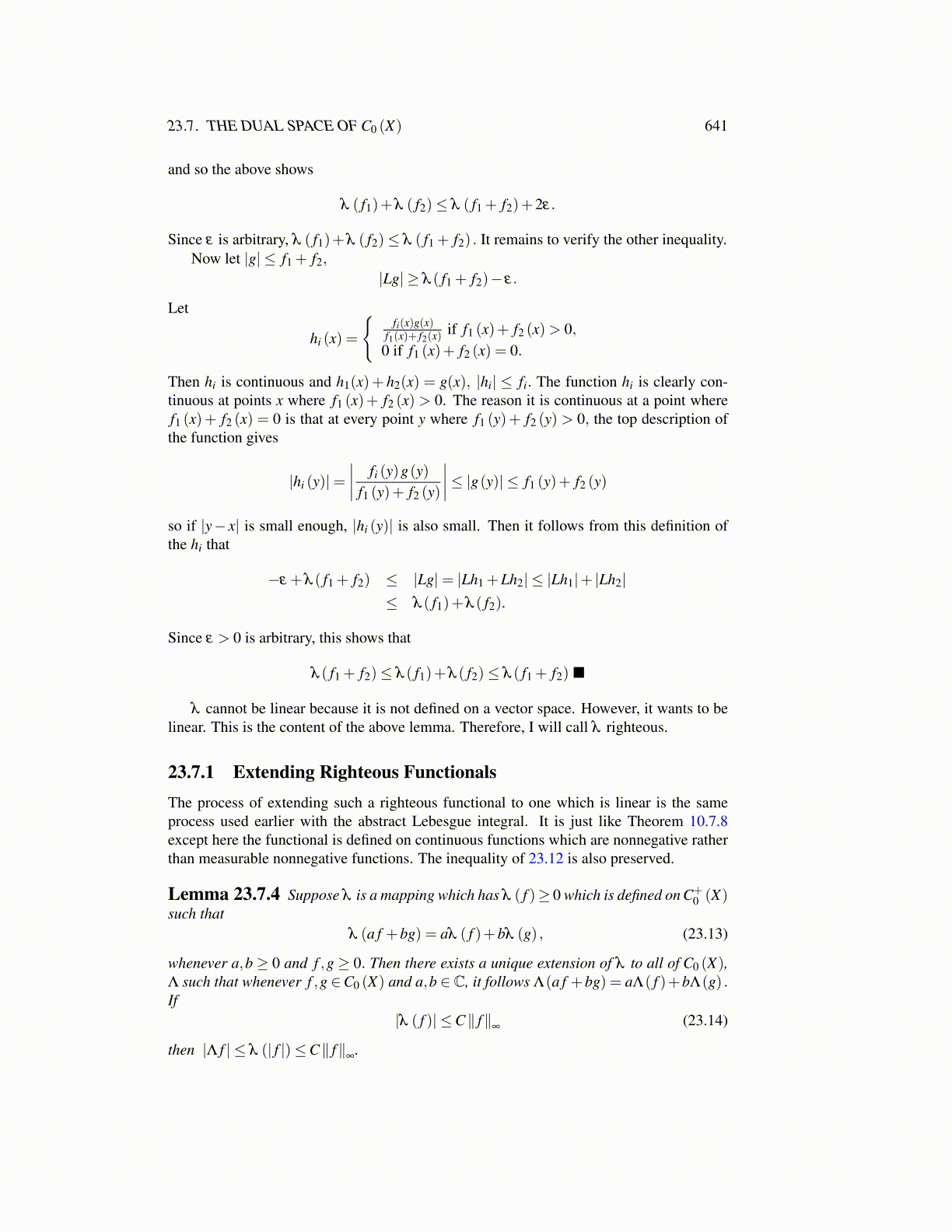
23.7. THE DUAL SPACE OF C0 (X) 641
and so the above shows
λ ( f1)+λ ( f2)≤ λ ( f1 + f2)+2ε.
Since ε is arbitrary, λ ( f1)+λ ( f2)≤ λ ( f1 + f2) . It remains to verify the other inequality.Now let |g| ≤ f1 + f2,
|Lg| ≥ λ ( f1 + f2)− ε.
Let
hi (x) =
{fi(x)g(x)
f1(x)+ f2(x)if f1 (x)+ f2 (x)> 0,
0 if f1 (x)+ f2 (x) = 0.
Then hi is continuous and h1(x)+ h2(x) = g(x), |hi| ≤ fi. The function hi is clearly con-tinuous at points x where f1 (x)+ f2 (x) > 0. The reason it is continuous at a point wheref1 (x)+ f2 (x) = 0 is that at every point y where f1 (y)+ f2 (y) > 0, the top description ofthe function gives
|hi (y)|=∣∣∣∣ fi (y)g(y)
f1 (y)+ f2 (y)
∣∣∣∣≤ |g(y)| ≤ f1 (y)+ f2 (y)
so if |y− x| is small enough, |hi (y)| is also small. Then it follows from this definition ofthe hi that
−ε +λ ( f1 + f2) ≤ |Lg|= |Lh1 +Lh2| ≤ |Lh1|+ |Lh2|≤ λ ( f1)+λ ( f2).
Since ε > 0 is arbitrary, this shows that
λ ( f1 + f2)≤ λ ( f1)+λ ( f2)≤ λ ( f1 + f2) ■
λ cannot be linear because it is not defined on a vector space. However, it wants to belinear. This is the content of the above lemma. Therefore, I will call λ righteous.
23.7.1 Extending Righteous FunctionalsThe process of extending such a righteous functional to one which is linear is the sameprocess used earlier with the abstract Lebesgue integral. It is just like Theorem 10.7.8except here the functional is defined on continuous functions which are nonnegative ratherthan measurable nonnegative functions. The inequality of 23.12 is also preserved.
Lemma 23.7.4 Suppose λ is a mapping which has λ ( f )≥ 0 which is defined on C+0 (X)
such thatλ (a f +bg) = aλ ( f )+bλ (g) , (23.13)
whenever a,b ≥ 0 and f ,g ≥ 0. Then there exists a unique extension of λ to all of C0 (X),Λ such that whenever f ,g ∈C0 (X) and a,b ∈C, it follows Λ(a f +bg) = aΛ( f )+bΛ(g) .If
|λ ( f )| ≤C∥ f∥∞
(23.14)
then |Λ f | ≤ λ (| f |)≤C∥ f∥∞
.